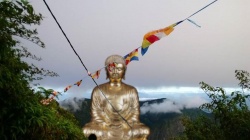Guṇabhadra
Guṇabhadra (求那跋陀羅, 394–468) means Merit worthy (功德賢). He was from central India. Being in the Brahmin Caste, he started the five studies as a child, and learned Astrology, literature, medicine, and Mantra practices. After studying the Heart Treatise on the Abhidharma, he turned to the teachings of The Buddha, renounced family Life, and became a fully ordained Monk.
Guṇabhadra first studied the Tripiṭaka of the Small Vehicle, then Mahāyāna teachings. With profound understanding of the Mahā-Prajñā-Pāramitā Sūtra and the Mahāvaipulya Sūtra of Buddha Adornment, he began to teach. He even converted his father to Buddhism.
In 435, the twelfth year of the Yuanjia (元嘉) years of the Liu Song Dynasty (劉宋, 420–79), Guṇabhadra went to China by sea. Emperor Wen (文帝) sent an emissary to welcome and take him to the Qihuan Temple (祇洹寺) in Jiankang (建康), present-day Nanjing. With the help of Huiyan (慧嚴), Huiguan (慧觀), and student Monks, he translated the Saṁyukta Āgama (T02n0099) in 50 fascicles.
Guṇabhadra’s Life in China spanned the reigns of three emperors—Wen, Xiaowu, and Ming (文帝、孝武帝、明帝)—and he was highly revered by all of them. Because of his contribution to the Mahāyāna teachings, people called him Mahāyāna. Altogether, he translated, from Sanskrit into Chinese, fifty-two sūtras in 134 fascicles, including the Sūtra of the Great Dharma Drum (T09n0270), the Śrīmālā Devi Sūtra (T12n0353), the 4-fascicle version of the Laṅkāvatāra Sūtra (T16n0670), and the Mantra for [[Rebirth in Amitābha Buddha’s [ure land]] (Mantra 5). Guṇabhadra died in 468, at the age of seventy-five. On the day he died, he saw celestial Flowers and the holy images of Amitābha Buddha and His retinue.
